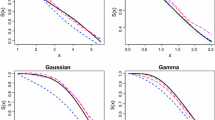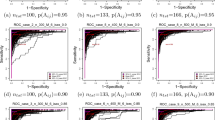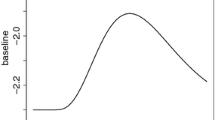Abstract
The joint modeling of longitudinal and time-to-event data is an active area in biostatistics research. The focus of this article is on developing a modeling framework for these joint models when the longitudinal and time-to-event data do not have a meaningful time-zero. The motivating example is the study of a longitudinal assessment of station during child labor and its relationship to time-to-delivery. A good predictor of delivery type and timing would help obstetricians better manage the end of pregnancy and better facilitate delivery. One measure of labor progression is station, a measure of the position of the fetus’ head in relation to the pelvis of the pregnant women, may be a good marker for delivery time and type. However, women enter the hospital, where their station is closely monitored, at arbitrary points in their labor process, resulting in no clear time zero. In addition, since delivery may be of various types, the competing risks due to type need to be accounted for. We develop a joint model of longitudinal and time-to-event data for this situation. The model is formulated through shared random effects between the survival and longitudinal processes, and parameter estimation is conducted through a Bayesian approach. The model is illustrated with longitudinal data on station where the relationship between station and event-time is studied and the model is used to assess the ability of longitudinal measures of station to predict the type and timing of pregnancy. We illustrate the methodology with longitudinal data taken during labor.




Similar content being viewed by others
References
Abranowitz M, Stegun IA (1972) Handbook of mathematical functions with formulas, graphs, and mathematical tables. Dover Publications Inc, New York
Celeux G, Forbes F, Robert CP, Titterington DM (2006) Deviance information criteria for missing data models. Bayesian Anal 1:651–674
Chen M-H, Dey DK, Shao Q-M (1999) A new skewed link model for dichotomous quantal response data. J Am Stat Assoc 94:1172–1186
Chen M-H, Shao OM, Ibrahim JG (2000) Monte Carlo methods in Bayesian computation. Springer, New York
Cowles C, Carlin BP (1996) Markov chain Monte Carlo convergence diagnostics: a comparative review. J Am Stat Assoc 91:883–904
Hastings WK (1970) Monte Carlo sampling methods using Markov chains and their applications. Biometrika 57:97–109
Kim S, Chen M-H, Dey DK (2008) Flexible generalized t-link models for binary response data. Biometrika 95:93–106
Liu JS (1994) The collapsed Gibbs sampler in Bayesian computations with applications to a gene regulation problem. J Am Stat Assoc 89:958–66
McLain AC, Albert PS (2014) Modeling longitudinal data with a random change point and no time-zero: applications to inference and prediction of the labor curve. Biometrics 70:1052–1060
Rizopoulos D (2012) Joint models for longitudinal and time-to-event data: with applications in R. Chapman & Hall/CRC, Boca Raton
Spiegelhalter DJ, Best NG, Carlin BP, van der Linde A (2002) Bayesian measures of model complexity and fit (with discussion). J R Stat Soc B 64:583–639
Acknowledgements
This research of Drs. Kim and Albert was supported by the intramural research program of National Cancer Institute.
Author information
Authors and Affiliations
Corresponding author
Rights and permissions
About this article
Cite this article
Kim, S., Buhule, O.D. & Albert, P.S. A Joint Model Approach for Longitudinal Data with no Time-Zero and Time-to-Event with Competing Risks. Stat Biosci 11, 449–464 (2019). https://doi.org/10.1007/s12561-019-09252-4
Received:
Revised:
Accepted:
Published:
Issue Date:
DOI: https://doi.org/10.1007/s12561-019-09252-4




